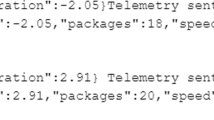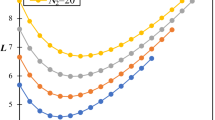Abstract
In this paper, we propose a procedure for production flow control in reentrant manufacturing systems. The system under study consists ofN machines and producesM product types simultaneously. Each part goes through the system following a predefined process and may visit a machine many times. All machines are subject to random failures and need random repair times. The scheduling objectives are to keep the production close to demand and to keep the WIP inventory level and cycle times at low values. The model is motivated by semiconductor fabrication production. A three-level hierarchical controller is constructed to regulate the production. At the top level of this hierarchy, we perform capacity planning by selecting the desirable buffer sizes and the target production level for each operation. A production flow rate controller is at the middle level which recalculates the production rates whenever a machine fails or is starved or blocked. The loading times for individual parts are determined at the bottom level of the hierarchy. Comparison with alternative control is made through simulation and it shows that the control policy performs well.
Zusammenfassung
In diesem Beitrag wird ein hierarchischer Planungsansatz zur Steuerung eines Produktionssystems mitN Maschinen betrachtet. Für jede von vielen herzustellenden Produktarten ist die Maschinenfolge durch den jeweiligen Produktionsprozeß fest vorgegeben. Gegebenenfalls sind Maschinen mehrmals zu durchlaufen. Außerdem sind zufällige Maschinenausfälle und Reparaturzeiten zu beachten. Solche Systeme treten z.B. bei der Halbleiterfertigung auf. Ziel der Planung ist eine möglichst bedarfssynchrone Produktion bei niedrigen Lagerbeständen an Halbfertigfabrikaten und hohen Produktionsraten. In der obersten Ebene einer dreistufigen Planungshierarchie werden im Rahmen einer Kapazitätsplanung wünschenswerte Puffergrößen und Produktionsraten der Maschinen ermittelt. In der mittleren Ebene erfolgt eine Anpassung der Produktionsraten, um Störungen des Systems durch Maschinenausfälle oder Blockierung von Maschinen zu beseitigen. In der untersten Planungsebene wird eine Durchlaufterminierung vorgenommen. Eine Simulationsuntersuchung zeigt, daß der vorgeschlagene Planungsansatz gute Ergebnisse liefert.
Similar content being viewed by others
References
Akella R, Kumar PR (1986) Optimal Control of Production Rate in a Failure Prone Manufacturing System. IEEE Transaction on Automatic Control AC-31(2): 116–126
Bai SX, Gershwin SB (1994) Scheduling Manufacturing Systems With Work-In-Process Inventory Control: Multiple-Part-Type Systems. Product Res 32(2): 365–385
Bai SX, Gershwin SB (1995) Scheduling Manufacturing Systems With Work-In-Process Inventory Control: Single-Part-Type Systems. IIE Transactions 27: 599–617
Bai, SX, Srivatsan N, Gershwin SB (1990) Hierarchical realtime scheduling of a semi-conductor fabrication facility. IEEE/CHMT IEMT (International Electronics Manufacturing Technology) Symposium, Washington, DC, October
Brook A, Kendrick D, Meeraus A (1988) GAMS: A User's Guide. The Scientific Press
Burman MH (1991) Recent Trends in Production Research. Technical report, Operations Research Center. MIT
Darakananda B (1989) Simulation of Manufacturing Process Under a Hierarchical Control Structure. Master's thesis, MIT
Deleersnyder J-L, Hodgson TJ, Muller H, O'Grady PJ (1989) Kanban Controlled Pull Systems: An Analytic Approach. Manag Sci 35: 1079–1092
Gershwin SB (1989) Hierarchical Flow Control: A Framework for Scheduling and Planning Discrete Events in Manufacturing Systems. Proceedings of the IEEE, Special Issue on Dynamics of Discrete Event Systems. 77(1): 195–209
Glassey CR, Resende MGC (1988) Close-Loop Job Release for VLSI Circuit Manufacturing. IEEE Transactions on Semiconductor Manufacturing 1(1): 36–46
Graves SC (1981) A Review of Production Scheduling. Oper Res 29(4):646–675
Kimemia J, Gershwin SB (1983) An Algorithm for the Computer Control of a Flexible Manufacturing System. IIE Transactions 15(4): 353–362
Mitra D, Mitrani I (1990) Analysis of a Kanban Discipline for Cell Coordination in Production Lines. I. Manag Sci 36(12): 1548–1566
Pegden CD, Shannon RE, Sadowski RP (1995) Introduction to Simulation Using SIMAN. McGraw Hill
Rodammer FA, White KF (1988) A Recent Survey of Production Scheduling. IEEE Transactions on Systems, Man, and Cybernetics 18(6): 841–851
Sarker BR, Fitzsimmons JA (1989) The Performance of Push and Pull System: A Simulation and Comparative Study. Int J Product Res 27: 1715–1732
Spearman M, Woodruff D, Hopp W (1990) A Pull Alternative to Kanban. Int J Product Res 28(5): 879–894
Wein LM (1988) Scheduling Semiconductor Wafer Fabrication. IEEE Transactions on Semiconductor Manufacturing 1(3): 115–130
Wein LM (1990) Scheduling Networks of Queues: Heavy Traffic Analysis of a Two-Station Closed Network with Controllable Inputs. Oper Res 38(6): 1065–1078
Author information
Authors and Affiliations
Rights and permissions
About this article
Cite this article
Bai, S.X., Gershwin, S.B. Scheduling manufacturing systems with work-in-process inventory control: Reentrant systems. OR Spektrum 18, 187–195 (1996). https://doi.org/10.1007/BF01540154
Received:
Accepted:
Issue Date:
DOI: https://doi.org/10.1007/BF01540154




